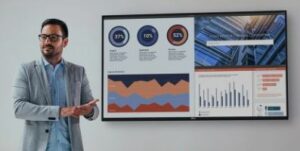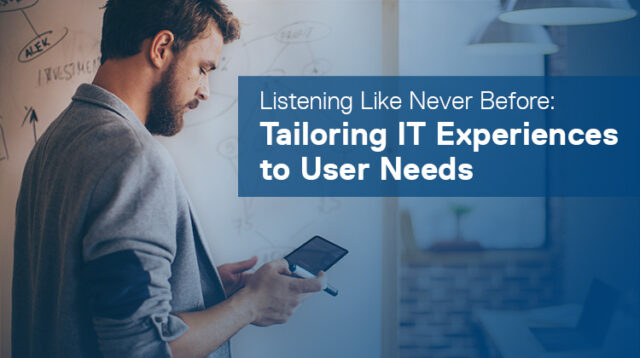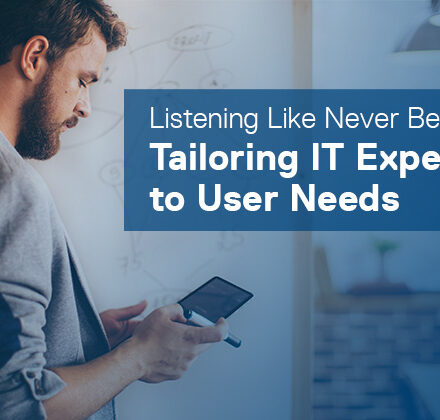Last November, I blogged about the evolving role of IT as a key strategic business partner, and how we are enabling Dell to attract and retain the best talent in today’s highly competitive digital world of modern, mobile, collaborative tools and services.

Since then, we’ve been busy enhancing the tools and services crucial to this workforce enablement transformation and we are also changing how we operate in a way that warrants a closer look. While developing a modern technology approach to ensure IT is positioned to meet the needs of our workforce, we are conscious that success is truly found when we optimize People, Process and Technology. With this in mind, we are ensuring we listen to and communicate with our users in new ways. And we are now using this data to calibrate on workforce feedback and prioritize future investment as we work to meet their needs.
Digital Workforce Transformation
As obvious as it may seem, regularly communicating team member experience updates and soliciting experiential feedback is highly valuable and insightful. However, this isn’t something that our IT teams have prioritized and invested in—until now, with the recent advent of Digital Workforce Transformation.
Like all IT teams our End User Support and Service Desk teams capture “CSAT” specific to break-fix-support and service delivery. This data tends to be highly indexed on a single event between the support technician and the end user. This service delivery data is essential but does not provide insight into the “water cooler” style conversations and broader sentiment around IT. Until now we had no way to capture data around comments like ‘why doesn’t it just work, we need more modern tech, my tech at home is better than this,’ etc.
Aligning User Needs with IT Pulse Scores
 To bridge this gap, we developed a quarterly Team Member Experience survey, our “IT Pulse.” The Pulse Survey participant group is tailored to reflect our global workforce. The survey asks one primary question— “How do you rate IT”— and several secondary and service specific questions — “How do you rate remote connectivity,” “How do you rate IT collaboration tools,” “How do you rate on-site support,” etc. This Pulse is now our primary data source and tool to ensure our IT investment strategy is aligned with our user needs. The survey probes further into team members’ views around the overall IT experience — and provides Voice of the Customer feedback into what we are doing right and what we need to do better.
To bridge this gap, we developed a quarterly Team Member Experience survey, our “IT Pulse.” The Pulse Survey participant group is tailored to reflect our global workforce. The survey asks one primary question— “How do you rate IT”— and several secondary and service specific questions — “How do you rate remote connectivity,” “How do you rate IT collaboration tools,” “How do you rate on-site support,” etc. This Pulse is now our primary data source and tool to ensure our IT investment strategy is aligned with our user needs. The survey probes further into team members’ views around the overall IT experience — and provides Voice of the Customer feedback into what we are doing right and what we need to do better.
These quarterly results are coupled with insights gained from our regular business engagement which now includes a review of latest IT Pulse scores for each business segment. This allows us to most effectively identify pain point and investment areas. We then act to address these areas and the results have exceeded our expectations. Over the past year, our IT Pulse score has climbed from 54 to 69 percent and we are now aiming to hit 80 percent by end of 2019.
Benefits have gone well beyond numbers on a graph, as the customer insights have literally changed our technology direction. We have gone from delivering an internally derived technology IT roadmap to tailoring our investments to business needs. We recognize their feedback as our best source of direction for future digital workforce capability.
Hey, IT, It’s Not the Email…
To see what a difference listening to users has made in our IT direction, consider this:
Based on our traditional IT roadmap process, we were prioritizing migration to a new email platform. However, our Pulse results revealed that team members rated email as one of our top services. It wasn’t a pain point for them at all. On the other hand, remote connectivity and mobile collaboration were among the lowest scoring services on the survey, but we didn’t have an investment plan or an action plan for those areas.
 We recalibrated, moved email down the priority list and focused heavily on remote connectivity and mobile productivity, and we saw our survey results climb as a result. We are modernizing our VPN and conferencing capabilities and our ongoing roll out of Workspace One from VMware and Outlook Anywhere is a huge hit.
We recalibrated, moved email down the priority list and focused heavily on remote connectivity and mobile productivity, and we saw our survey results climb as a result. We are modernizing our VPN and conferencing capabilities and our ongoing roll out of Workspace One from VMware and Outlook Anywhere is a huge hit.
We no longer define IT’s investments based on a long-term roadmap but instead hone our improvement focus via our survey results quarter-to-quarter. We try things; we learn fast and we make quick changes and course corrections. Prompt feedback is a big win for us. As IT leaders we can be confidant in the knowledge we are investing and working in the right areas that really matter to our team members.
It is a big change for an organization that is accustomed to planning everything before we do anything and aligns well to a modern, agile, customer-centric way of working.
An Ongoing Conversation
Beyond the survey, we’ve invested in communications capabilities to ensure team members know we are listening, reacting to feedback and actively working to meet their needs. We highlight new services, tools, and processes that make their jobs easier in regular newsletters, emails, and “Got a Minute” 60-second “how to” videos.
Based on user findings, we know people like having the option to connect with IT techs face-to-face. To facilitate this, we offer an expanding network of Tech Central hubs—physical help centers around the globe. At Tech Central, team members can walk in and speak directly with our technicians to get answers or help with device issues.
In our latest outreach effort, we unveiled a “listening post” feature called TMX Connect. TMX stands for Team Member eXperience. This is an interactive intranet page where all users can pose questions on technical issues, offer feedback, discuss industry trends, and get quick responses from senior technical staff, product managers and IT leaders.
Summary
IT is listening in a new way, and so are our executives. Our TMX team engages with leadership in frequent sessions to review what we are hearing from team members. We now meet regularly with the head of Dell Digital and Services as part of our executive dialogue. It is all part of Digital Workforce Transformation at Dell, driven by a strategic need to attract and retain talent by enabling our team members to be their best and do their best work at Dell.


